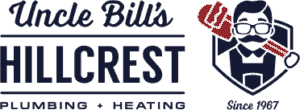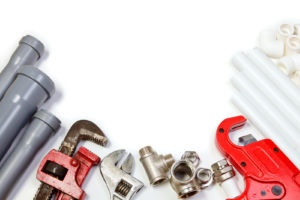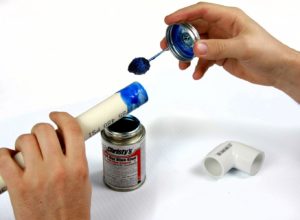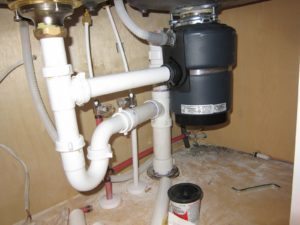Here are few tips and tricks that every do-it-yourselfer needs to know.
Our guys at Hillcrest Plumbing want you to know some things that they don’t teach in high school but can save you hours of time, hundreds of dollars, and certainly insurmountable amounts of frustration as you go about your plumbing projects as a beginner.
1. PVC and CPVC pipes are two entirely different things. If you go to the store and do not know which one to ask for, you risk buying a pipe that will not be able to do the job that you need. Even the way we measure these pipes are different, so not only will the pipe likely not fit, they both do different things.
2. CPVC pipe is much more preferable for hot water. Typically professional plumbers will use PVC pipe for cold water and regular water lines and CPVC pipe for hot water lines or things like a dishwasher or a washing machine that often have hot water running through them.
3. They are measured differently. For PVC pipe, one would measure the diameter of the inside of the pipe. Whereas with CPVC pipe the measurement is taken based on the diameter of the outside of the pipe. A simple solution to make sure that you get exactly what you are looking for without having to go the store over and over again purchasing the wrong product, is to take a small piece of the pipe that you are looking to fit and replace. The people at the hardware store will be able to tell you what type of pipe it is and the correct measurement.
4. Another fun fact: When dealing with PVC, you may find that there are two of everything! If you look a little bit closer at the fine print on the packaging there will be a little indicator to tell the two apart. One will have the indicator schedule 40 which is meant only for the use of pressurized hot water lines. The other indicator will read DWV. DVW indicates that these pipes are meant for drains, valves, and waterlines.
5. Though there are many different types of pipes, they do make universal cutters for all types that may be worth investing in.
6. It doesn’t stop with different types of piping. There are also different types of products for each kind of piping as well. So if you need glue, you need to make sure that the glue coordinates with the kind of pipe you intend on gluing, which of course means that you have to know that there are different kinds of pipes and the kind of pipe that you are trying to glue.
7. Another thing to note before you glue. You have to first apply a primer. The primer is something that home inspectors check for to ensure that the job was done right. Primers will also have to correlate with the type of piping that you are priming.
8. Whatever you are working with whether it be the kitchen, the bathroom, or some other area of your home, you might consider adding a shut-off valve. Though it may seem like an unnecessary step, it certainly adds convenience in that you can shut off the water to a certain area of your home that you’re working on without having to shut the water off to the entire house. So if you are changing the drain in the sink, you can still take a shower from the dirty job while the glue dries on your pipes in the kitchen.
9. Plumbing is very specific when it comes to home inspections. Local codes may have variances, but inspectors do check to make sure that things are done right. If you’re not sure and you live in the Lower Mainland, an expert from the Hillcrest plumbing team would be happy to guide you.
10. The diameter of a shower drain must measure exactly 2” in diameter and maintain this diameter all the way to the main line in order for it to be in regulatory compliance.
11. There is more flexibility for toilet drains. They can vary in diameter from 3”-4,” but the larger one is always preferable and is less likely to have problems with clogs and back-ups.
12. Vent pipes are required along the exterior of your home for all toilets. Each toilet must have one unless there are toilets that are close enough together that they are able to connect to the same vent pipe.
13. Toilets must also each have a clean out, which allows for easy accessibility for a plumber to access and unclog back-ups and build-ups. The same rule applies here for multiple toilets. They must each have one, but can share a clean out if they are close enough to be connected to the same one.
14. Most sinks have what is called a P trap which is a removable pipe that is often the source of build-ups and clogs. Most drains can be unclogged by simply removing the P trap and taking out any debris and things that are caught inside.
15. Lower water pressure is often related to one of three things: a leaky faucet, clogged aerators, or a blockage in your pipes. All of which are very basic problems that can be tackled by most DIY’s.
16. A water bill that jumps suddenly is often due to a leaky toilet or a toilet that is running constantly. While this isn’t always the case, the majority of water expenses are due to the frequent use of water in bathrooms, thus indicating that if there is a significant increase there is a high likelihood that this is the source.
17. Constantly running toilets are toilets that seem to run all the time. This issue is usually caused by a flapper that has gone bad. The flapper is a rubber part inside the back of the toilet that can often be found at the hardware store for under $10 and it only takes about ten minutes to replace.
18. Quite possibly the most common plumbing problem is that of a leaky faucet. These can also be caused by the wearing of an aerator, but could also indicate the need for replacement of a washer, rubber seal, or an o ring. These are all products that can be found at the hardware store for next to nothing and easily replaced by a beginning do-it-yourselfer with little hassle.



